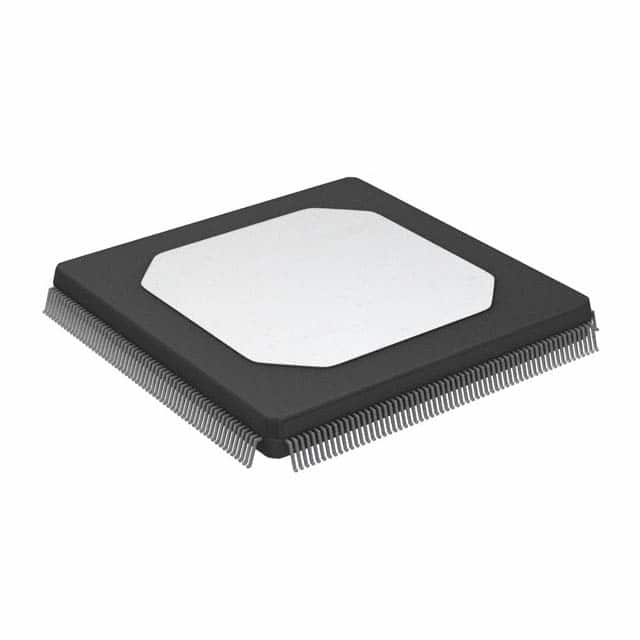Lihat spesifikasi untuk detail produk.

ADSP-21062KSZ-160
Product Overview
Category
The ADSP-21062KSZ-160 belongs to the category of digital signal processors (DSPs).
Use
This DSP is designed for various applications that require high-performance signal processing, such as audio and video processing, telecommunications, and industrial control systems.
Characteristics
- High-performance processing capabilities
- Efficient execution of complex algorithms
- Low power consumption
- Real-time processing capabilities
- Integrated peripherals for enhanced functionality
Package
The ADSP-21062KSZ-160 comes in a compact package, allowing for easy integration into different electronic devices and systems.
Essence
The essence of the ADSP-21062KSZ-160 lies in its ability to perform advanced signal processing tasks with high efficiency and accuracy.
Packaging/Quantity
The DSP is typically packaged individually and is available in various quantities depending on the manufacturer's specifications.
Specifications
- Model: ADSP-21062KSZ-160
- Architecture: Harvard
- Clock Speed: 160 MHz
- Instruction Set: Modified Harvard Architecture Single Instruction Multiple Data (SIMD)
- Data Width: 32-bit
- Memory: On-chip RAM and ROM
- I/O Interfaces: Serial, parallel, and general-purpose I/O ports
- Power Supply: 3.3V
Detailed Pin Configuration
The ADSP-21062KSZ-160 has a specific pin configuration that enables connectivity and communication with other components. The detailed pin configuration can be found in the product datasheet provided by the manufacturer.
Functional Features
- High-speed arithmetic and logic unit (ALU) for efficient computation
- Multiple data paths for parallel processing
- DMA controller for direct memory access
- Integrated serial ports for data communication
- On-chip memory for program storage and data buffering
- Interrupt controller for handling real-time events
Advantages and Disadvantages
Advantages
- High processing power for complex algorithms
- Real-time processing capabilities
- Low power consumption
- Integrated peripherals reduce the need for external components
- Compact package for easy integration
Disadvantages
- Limited availability of alternative models
- Higher cost compared to some other DSPs in the market
Working Principles
The ADSP-21062KSZ-160 operates based on the principles of digital signal processing. It receives input signals, performs mathematical operations, and produces output signals with enhanced quality or specific characteristics. The DSP's architecture and specialized instructions enable efficient execution of algorithms, making it suitable for real-time applications.
Detailed Application Field Plans
The ADSP-21062KSZ-160 finds applications in various fields, including:
- Audio and Video Processing: The DSP can be used in audio and video systems to enhance sound quality, perform noise reduction, and enable video encoding/decoding.
- Telecommunications: It is utilized in telecommunication systems for tasks like voice compression, echo cancellation, and modulation/demodulation.
- Industrial Control Systems: The DSP can be integrated into industrial control systems to process sensor data, control actuators, and implement feedback control algorithms.
Detailed and Complete Alternative Models
While the ADSP-21062KSZ-160 is a highly capable DSP, there are alternative models available in the market that offer similar functionalities. Some notable alternatives include:
- ADSP-21061KSZ-80: A lower clock speed variant with reduced power consumption.
- ADSP-21063KSZ-240: A higher clock speed variant for applications requiring even more processing power.
- TMS320C6713: A DSP from Texas Instruments with comparable performance and features.
These alternative models provide flexibility in choosing a DSP that best suits specific application requirements.
Word count: 496 words
Sebutkan 10 pertanyaan dan jawaban umum terkait penerapan ADSP-21062KSZ-160 dalam solusi teknis
Question: What is the maximum operating frequency of ADSP-21062KSZ-160?
Answer: The maximum operating frequency of ADSP-21062KSZ-160 is 160 MHz.Question: What are the key features of ADSP-21062KSZ-160?
Answer: Some key features of ADSP-21062KSZ-160 include a 32-bit fixed-point DSP core, on-chip memory, and various peripherals for interfacing with external components.Question: Can ADSP-21062KSZ-160 be used in real-time signal processing applications?
Answer: Yes, ADSP-21062KSZ-160 is suitable for real-time signal processing applications due to its high processing speed and dedicated DSP architecture.Question: What are the power supply requirements for ADSP-21062KSZ-160?
Answer: ADSP-21062KSZ-160 typically requires a single 3.3V power supply for operation.Question: Is ADSP-21062KSZ-160 compatible with common development tools and software?
Answer: Yes, ADSP-21062KSZ-160 is compatible with popular development tools and software such as VisualDSP++.Question: What are the typical applications of ADSP-21062KSZ-160?
Answer: ADSP-21062KSZ-160 is commonly used in audio processing, motor control, telecommunications, and industrial automation applications.Question: Does ADSP-21062KSZ-160 support external memory expansion?
Answer: Yes, ADSP-21062KSZ-160 supports external memory expansion through its external memory interface.Question: What are the available communication interfaces on ADSP-21062KSZ-160?
Answer: ADSP-21062KSZ-160 features multiple communication interfaces including UART, SPI, and I2C for connecting to external devices.Question: Can ADSP-21062KSZ-160 be used in low-power applications?
Answer: Yes, ADSP-21062KSZ-160 offers power-saving modes and can be used in low-power applications with proper design considerations.Question: Are there any known limitations or considerations when using ADSP-21062KSZ-160 in technical solutions?
Answer: While ADSP-21062KSZ-160 is a versatile DSP, designers should consider its power consumption, heat dissipation, and potential need for external components for specific applications.

